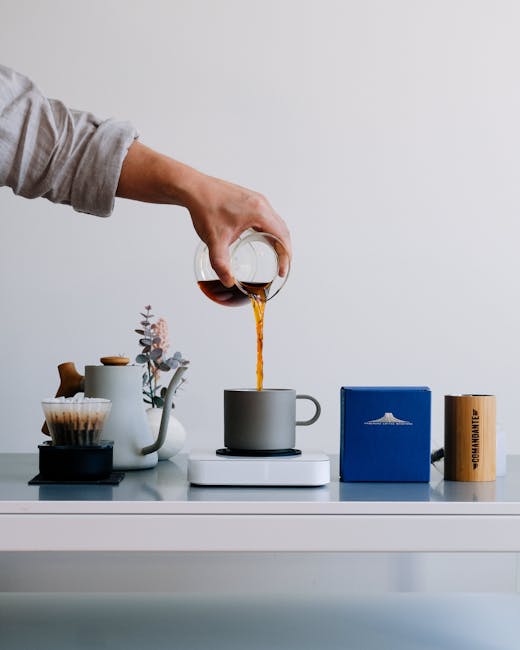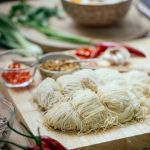The Perfect Espresso Tonic, a seemingly simple yet surprisingly complex beverage, represents a fascinating intersection of classic caffeination and contemporary mixology. While pinpointing its exact origin is difficult, its rise to prominence can be attributed to the burgeoning specialty coffee scene of the late 2000s and early 2010s. This period saw a dramatic increase in consumer appreciation for high-quality espresso and a concurrent exploration of innovative coffee-based cocktails. The Espresso Tonic, with its refreshing contrast of bitter espresso and effervescent tonic water, perfectly embodies this trend, appealing to both coffee purists and cocktail enthusiasts alike.
Unlike many classic cocktails with centuries of history, the Espresso Tonic’s lineage is relatively recent. Its precise inventor remains unknown, lost in the annals of coffee shop experimentation and bar innovation. However, its quick adoption suggests a natural evolution rather than a deliberate invention. The combination of the robust, concentrated flavor of espresso with the clean, botanical notes of tonic water proved unexpectedly harmonious, creating a drink that’s both invigorating and subtly sophisticated. Its popularity likely stemmed from the desire for a less sugary, more sophisticated alternative to traditional coffee drinks and the growing trend of incorporating high-quality ingredients into everyday beverages.
The cultural significance of the Espresso Tonic lies in its reflection of modern beverage trends. Statistics show a significant increase in the consumption of both specialty coffee and premium mixers like tonic water in recent years, directly correlating with the Espresso Tonic’s growing popularity. This drink embodies a move away from mass-produced, heavily sweetened beverages towards a focus on quality ingredients and balanced flavor profiles. It’s a drink that appeals to a conscious consumer, one who appreciates the nuanced flavors of both coffee and tonic, and seeks a refreshing and less-sugary alternative to traditional caffeinated options. Interestingly, its rise in popularity also showcases a blurring of lines between coffee culture and cocktail culture, demonstrating a growing crossover appeal for beverages that blend both worlds.
Furthermore, the Espresso Tonic’s adaptability underscores its widespread appeal. While a classic recipe often employs a double shot of espresso and premium tonic water, garnished with a lemon twist, variations abound. Some include flavored tonics, adding citrus, herbal, or even floral notes to complement the espresso. Others incorporate additions like a splash of simple syrup or a dash of bitters for a more complex flavor profile. This flexibility allows for personalization and caters to a diverse range of palates, further contributing to its enduring popularity within the global coffee and cocktail community.
Ingredients and Measurements
Crafting the perfect Espresso Tonic hinges on the quality and precision of your ingredients. While seemingly simple, each component plays a crucial role in achieving the desired balance of bitterness, sweetness, and effervescence. We’ll break down each ingredient, offering recommendations and clarifying measurements to ensure your success.
Espresso: The foundation of this refreshing drink is, of course, the espresso. We recommend using 1-2 ounces (30-60ml) of freshly pulled espresso. The amount depends on your personal preference and the intensity of your espresso. A darker roast will generally require less espresso to avoid overpowering the tonic. Crucially, the espresso needs to be of high quality. Stale or poorly extracted espresso will significantly detract from the overall experience. Use freshly roasted beans and a well-maintained espresso machine for optimal results. If you’re using pre-ground espresso, ensure it’s finely ground and freshly ground immediately before brewing.
Tonic Water: The choice of tonic water is equally vital. Avoid overly sweet or artificial-tasting tonics. Opt for a high-quality tonic water with natural flavors and a subtle sweetness. We recommend using 4-6 ounces (120-180ml) of premium tonic water. Again, the amount is adjustable to your taste. If you prefer a stronger espresso flavor, use less tonic water. Conversely, for a more refreshing and less intense espresso taste, use more tonic water. Chill the tonic water thoroughly before use; this enhances the drink’s refreshment and prevents dilution of the espresso.
Ice: The ice is not just a cooling agent; it also contributes to the overall dilution and texture of the drink. Using large, clear ice cubes is recommended. These melt more slowly than smaller ice cubes, preventing rapid dilution and maintaining the drink’s temperature for longer. We suggest using at least 3-4 large ice cubes, depending on the size of your serving glass. Avoid using crushed ice, as it melts too quickly and can dilute the drink excessively.
Optional Garnishes: While not essential, garnishes can elevate the visual appeal and add subtle flavor complexity to your Espresso Tonic. A thin orange peel expressed over the drink before adding it to the glass releases aromatic oils, adding a citrusy note. Alternatively, a few sprigs of rosemary can provide a herbaceous and slightly piney aroma. A simple coffee bean placed on the rim of the glass can serve as a stylish and thematic garnish. Remember to use fresh, high-quality garnishes for the best results. Experiment with different garnishes to discover your preferred combination.
Important Note: Accurate measurements are crucial for a balanced Espresso Tonic. Using a scale for weighing the espresso and a measuring jigger for the tonic water ensures consistency and repeatability. Adjusting the ratios to your liking is encouraged once you have a baseline understanding of the recipe’s fundamental balance.
Equipment List: Perfect Espresso Tonic
Crafting the perfect Espresso Tonic requires precision and the right tools. While some items are essential, others enhance the experience. This list details the equipment, providing practical information and professional recommendations to ensure consistent, high-quality results.
Espresso Machine: A crucial component. You’ll need a machine capable of delivering a consistent 9 bars of pressure for optimal espresso extraction. Look for features like PID temperature control for precise brewing temperature management. While a professional-grade machine is ideal, a good quality home espresso machine will suffice. Consider a machine with a built-in grinder for ultimate convenience and freshness.
Grinder: A burr grinder is absolutely essential for consistent particle size. A conical burr grinder offers more precision and is preferred by many baristas, while flat burr grinders are also excellent choices. Avoid blade grinders; they produce uneven particle sizes leading to inconsistent extraction and bitter espresso. Aim for a grinder that allows for fine adjustments in grind size – this is crucial for dialing in your espresso shot perfectly.
Espresso Tamper: A 58mm tamper is standard for most espresso machines. However, check your portafilter’s dimensions to ensure compatibility. Choose a tamper with a flat, even base to ensure consistent pressure distribution during tamping. A 58mm tamper weighing between 15-25 kg is recommended for proper pressure application without over-tamping. The tamper’s weight and handle shape should feel comfortable, aiding in consistent tamping pressure.
Scale: A precise digital scale is paramount for measuring both coffee beans and the extracted espresso. Accuracy is key to consistency. Aim for a scale that measures in grams with at least 0.1g accuracy. This allows for precise measurements of both the coffee dose and the yield of the espresso shot. Accurate measurements are essential for consistent espresso extraction and the ideal Espresso Tonic ratio.
Timer: A timer is crucial for controlling the brewing time of the espresso shot. Aim for a timer that measures seconds accurately. This allows for precise timing of the shot, affecting its flavour profile significantly. Most espresso machines have a built-in timer, but a separate timer provides greater flexibility.
Tonic Water: Choose a high-quality tonic water with a delicate flavour profile that complements the espresso. Avoid excessively sweet or artificial-tasting tonic waters. Experiment with different brands to find your preferred taste. Approximately 150-200ml of tonic water is typically used per Espresso Tonic.
Glassware: A tall, slender glass, ideally a highball glass or Collins glass, is perfect for presenting your Espresso Tonic. The glass should be chilled for an optimal drinking experience. Approximately 250-300ml capacity will be sufficient.
Optional Equipment: A milk frother (for adding a touch of milk), a jigger for precise measurements, and a coffee thermometer for monitoring water temperature can enhance your Espresso Tonic experience, although they aren’t strictly essential for basic preparation.
Espresso Preparation: The Foundation of a Perfect Tonic
The espresso shot forms the crucial base of your Espresso Tonic, providing the rich, intense coffee flavor that will be balanced by the bright, crisp tonic. A poorly extracted shot will ruin even the best tonic, so meticulous preparation is key. This section details the process of achieving the perfect espresso for your refreshing cocktail.
Bean Selection: Start with high-quality, freshly roasted espresso beans. Look for beans with notes that complement tonic water – citrusy, floral, or subtly sweet profiles work particularly well. Avoid overly dark roasts, as their bitterness can overpower the delicate flavors of the tonic. A medium roast is generally ideal.
Grinding: The grind size is paramount. Too coarse, and the water will pass through too quickly, resulting in a weak, sour shot. Too fine, and the water will struggle to permeate the grounds, leading to a bitter, over-extracted espresso. Aim for a grind consistency resembling fine table salt. A quality burr grinder is highly recommended for consistent particle size, crucial for repeatable results. Adjust the grind size based on your specific espresso machine and beans. A slightly finer grind might be needed for older beans.
Dosing: A standard double shot of espresso typically uses 18-21 grams of ground coffee. This amount will vary depending on your portafilter basket size. Weigh your grounds using a digital scale for precision. This is far more accurate than eyeballing it and ensures consistency from shot to shot. Distribute the grounds evenly within the portafilter basket, ensuring no channeling (uneven distribution that leads to uneven extraction).
Tamping: Proper tamping creates a uniform puck of coffee grounds, essential for even water distribution during extraction. Use a calibrated tamper (typically 50-58 pounds of pressure) and apply consistent, even pressure across the entire surface of the grounds. Avoid tilting the tamper, as this can lead to channeling. A level, well-tamped puck is the foundation of a well-extracted shot.
Extraction: The ideal espresso extraction time is between 25-30 seconds. This is the time it takes for the water to pass through the coffee grounds. Factors affecting extraction time include grind size, tamping pressure, and water temperature. Monitor the extraction closely, adjusting the grind size if the time is consistently too short or too long. The ideal espresso will exhibit a rich crema (a layer of reddish-brown foam) on top, with a balanced flavor profile – not too sour, not too bitter.
Troubleshooting: If your espresso is sour, your grind is likely too coarse, or your extraction time is too short. If it’s bitter, your grind is likely too fine, or your extraction time is too long. Keep a detailed record of your grind size, extraction time, and the resulting flavor profile to help you fine-tune your process over time. Remember, consistency is key to mastering espresso preparation.
By following these steps, you’ll be well on your way to crafting the perfect espresso base for an unforgettable Espresso Tonic. Enjoy!
Tonic Water Selection and Chilling
The choice of tonic water is paramount in crafting the perfect Espresso Tonic. Unlike a simple gin and tonic, the delicate espresso notes require a tonic that complements, not overwhelms. Avoid overly sweet or artificially flavored tonics; opt for a premium tonic with a clean, crisp taste and a subtle bitterness that balances the espresso’s robust character. Look for tonics made with natural quinine and minimal added sugar.
Many high-quality tonic brands are available, each offering a slightly different profile. Experiment to find your preference. Some popular choices include Fever-Tree, Q Tonic, and Thomas Henry. Consider the quinine level: a higher quinine content will provide a more pronounced bitterness, which can be desirable for a stronger espresso. Conversely, a lower quinine content might be preferable if you’re using a lighter roast espresso.
The quantity of tonic water is a matter of personal taste, but a good starting point is a 2:1 ratio of tonic to espresso. For a standard double shot (approximately 60ml), you would use approximately 120ml of tonic water. However, don’t be afraid to adjust this ratio to your liking. Some prefer a more intense espresso flavor, while others prefer a lighter, more refreshing drink. Start with the 2:1 ratio and adjust accordingly in subsequent attempts.
Chilling both the tonic water and the espresso is crucial for achieving the desired refreshing effect and preventing the drink from becoming diluted too quickly. Proper chilling is key to maintaining the integrity of both the espresso and the tonic’s delicate flavors. Ideally, chill the tonic water thoroughly before serving. This can be achieved by storing the bottle in the refrigerator for at least two hours, or even overnight. Ice-cold tonic water will significantly enhance the overall drinking experience.
For the espresso, while you may not chill the espresso itself, ensuring your espresso machine is properly warmed up and producing consistently excellent espresso is essential. A correctly pulled shot will be at the optimum temperature, though it will naturally cool slightly as it sits. If your espresso is overly hot, it will quickly melt ice and dilute the drink, impacting the flavor profile. Aim for a freshly pulled shot that’s hot but not scalding.
Consider using large ice cubes in your glass. These melt slower than smaller cubes, minimizing dilution and maintaining the desired temperature for a longer period. You can make your own large ice cubes by freezing water in a silicone ice cube tray or a suitable container. The larger surface area of the ice compared to smaller cubes also helps to chill the drink more effectively.
Finally, remember that the quality of your ingredients directly impacts the final drink. Using high-quality tonic water and freshly pulled espresso will significantly elevate your Espresso Tonic. Experiment with different tonic brands and espresso roasts to discover your perfect combination. Don’t be afraid to experiment and find what suits your palate best!
Mixing and Layering Techniques for the Perfect Espresso Tonic
Achieving the perfect Espresso Tonic isn’t just about the quality of the espresso and tonic; it’s also about mastering the art of mixing and layering. The goal is a balanced drink with a visually appealing presentation. There are several techniques, each resulting in a slightly different experience.
Method 1: The Gentle Stir This is the simplest method, ideal for those who prefer a well-integrated drink. Start by preparing a double shot (approximately 60ml) of high-quality espresso. Chill a highball glass (approximately 300ml) beforehand. Pour the espresso into the glass. Then, add 180ml of chilled, premium tonic water. Using a long spoon or bar spoon, gently stir the mixture three to five times, ensuring you don’t over-stir and create excessive foam. This method allows for a subtle blend of the espresso’s bitterness and the tonic’s effervescence.
Method 2: The Layered Approach This method emphasizes visual appeal and a gradual flavor transition. Begin, as before, with your chilled highball glass and 60ml of freshly pulled espresso. Slowly pour the chilled tonic water down the side of the glass, using the back of a spoon to guide the flow. This creates distinct layers, allowing you to initially taste the espresso, followed by the gradual introduction of the tonic’s refreshing notes. Avoid vigorous pouring which will disrupt the layering effect. Use a high-quality tonic water with a pronounced citrus note to enhance the visual contrast.
Method 3: The Ice Cube Method This technique offers a controlled release of the tonic’s carbonation and a delightful cooling effect. First, prepare your 60ml of espresso and place several large ice cubes in your chilled highball glass. Then, carefully pour the espresso over the ice. Finally, slowly add 180ml of chilled tonic water, allowing it to fizz gently around the ice cubes. This method helps to maintain the espresso’s intensity while gradually introducing the tonic’s refreshment. Using large ice cubes is crucial to prevent excessive dilution.
Professional Recommendations:
- Use high-quality ingredients: The success of an Espresso Tonic hinges on the quality of the espresso and tonic water. Experiment with different roasts and tonic brands to find your preferred combination.
- Chill your ingredients: Chilling both the glass and the ingredients significantly enhances the drinking experience, preventing rapid dilution and maintaining a crisp, refreshing taste.
- Garnish appropriately: A simple orange peel twist or a few thin slices of cucumber can elevate the presentation and complement the flavors.
- Experiment with ratios: Adjust the ratio of espresso to tonic water to suit your personal preference. Some might prefer a stronger espresso flavor, while others may prefer a lighter, more tonic-forward drink.
- Practice makes perfect: Mastering the mixing and layering techniques takes practice. Don’t be afraid to experiment and find the method that best suits your style and taste.
Regardless of the method you choose, remember that the key to a perfect Espresso Tonic lies in the balance between the espresso’s robust character and the tonic’s effervescence. Experiment with different techniques and ingredients to discover your own perfect recipe.
Garnish Suggestions for the Perfect Espresso Tonic
The garnish for your Espresso Tonic shouldn’t just be an afterthought; it should complement the drink’s inherent bitterness and effervescence, adding a visual appeal that elevates the overall experience. A well-chosen garnish can enhance the aromatic profile and provide a textural contrast, making your Espresso Tonic truly memorable.
Citrus Twists: A classic and highly effective garnish, a citrus twist adds brightness and complexity. For the Espresso Tonic, we recommend either orange or grapefruit. Use a vegetable peeler to create a long, thin strip of zest from either fruit, avoiding the bitter white pith. Express the oils from the twist over the drink by gently pressing and rubbing it against the rim of the glass before dropping it in. Use approximately 1-2 inches of zest per drink. The orange twist offers a sweeter, more familiar complement, while grapefruit provides a more assertive, tart counterpoint.
Rosemary Sprig: For a more herbaceous and sophisticated touch, consider a sprig of fresh rosemary. Its piney aroma pairs beautifully with the coffee’s intensity and the tonic’s subtle botanical notes. Select a sprig with about 3-4 leaves, ensuring it’s fresh and fragrant. Gently rinse the rosemary before adding it to the drink. The sprig adds a lovely visual element and a subtle, earthy aroma that lingers on the palate.
Coffee Beans: A simple yet elegant option, a few coffee beans can visually connect the espresso to the rest of the drink. Use 2-3 high-quality espresso beans, lightly roasted, for the best visual and aromatic impact. Their dark color contrasts beautifully against the light tonic and adds a subtle coffee aroma to the experience. Choose beans that are visually appealing and free from any defects. Avoid using overly oily beans, as they might cloud the drink.
Dehydrated Orange or Grapefruit Slice: For a modern and visually striking garnish, consider using a dehydrated citrus slice. These are easily made at home by thinly slicing the fruit and dehydrating it in a low oven (around 170°F/77°C) for several hours, or using a food dehydrator. A single, perfectly dehydrated slice adds a beautiful pop of color and a concentrated citrus flavor. The dehydration process intensifies the citrus notes, creating a fascinating flavor contrast with the bitterness of the espresso and tonic.
Edible Flowers: For a truly luxurious touch, consider adding edible flowers. Choose flowers that complement the coffee and tonic’s flavor profile, such as pansies or violas. A single, carefully placed flower adds a delicate touch of color and elegance. Ensure the flowers are organically grown and free from pesticides before adding them to your drink. Remember to use only edible flowers, as some flowers are toxic.
Important Considerations: Regardless of your chosen garnish, remember to keep it simple and elegant. Over-garnished drinks can appear cluttered and overwhelming. The garnish should enhance, not detract from, the overall drinking experience. Always use fresh, high-quality ingredients. A wilted herb or a bruised citrus peel will negatively impact both the visual and gustatory aspects of your Espresso Tonic.
Perfect Espresso Tonic: Recommendations
The Perfect Espresso Tonic is best enjoyed as a refreshing and invigorating beverage, ideally served chilled. For optimal taste, we recommend preparing it just before serving to prevent the tonic water from going flat and the espresso from losing its aroma. The combination of the bitter espresso and the subtly sweet tonic water creates a unique flavor profile that is both sophisticated and easily accessible.
Serving Suggestions: For the ultimate experience, serve your Perfect Espresso Tonic in a tall, chilled glass filled with ice. Garnish with a thin orange peel, a sprig of rosemary, or a few coffee beans for an added touch of elegance and aroma. Consider experimenting with different types of tonic water – some have a more pronounced citrus note, while others are more subtly flavored, allowing you to customize the drink to your preference. A simple yet effective presentation can significantly enhance the overall sensory experience.
Storage Conditions: While the individual components (espresso and tonic water) have different storage requirements, the Perfect Espresso Tonic itself is best enjoyed immediately after preparation. Do not store a pre-mixed Espresso Tonic. The espresso should be freshly brewed, and the tonic water should be kept chilled to maintain its carbonation. If you are preparing espresso in advance, store it in an airtight container in the refrigerator for no longer than 24 hours. Tonic water should be stored according to the instructions on the bottle, usually in a cool, dark place.
Complementary Dishes: The Perfect Espresso Tonic’s unique flavor profile pairs exceptionally well with a variety of dishes. Its subtle bitterness and refreshing qualities make it an ideal accompaniment to light desserts, such as lemon tarts, panna cotta, or biscotti. The coffee notes also complement savory dishes with a slight bitterness, such as grilled salmon with lemon, or a goat cheese and fig salad. For a truly sophisticated pairing, consider enjoying your Perfect Espresso Tonic alongside a selection of artisanal cheeses and cured meats. Avoid pairing it with overly sweet or heavy dishes, as these may overpower the delicate balance of flavors in the drink.
Nutritional Information (per serving, approximate values may vary based on ingredients used):
- Calories: Approximately 80-100 calories
- Carbohydrates: Approximately 20-25g
- Sugar: Approximately 15-20g (depending on the tonic water used)
- Protein: Negligible
- Fat: Negligible
- Caffeine: Approximately 60-80mg (depending on the espresso strength)
Note: Nutritional information is an estimate and may vary depending on the specific ingredients and quantities used.





